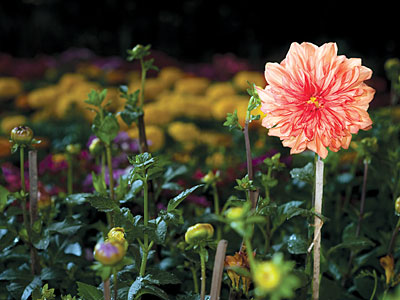 AHMAD ISKANDAR |
Look through the lyrics of Nepal's best-loved songs, and you may conclude this country has an obsession with flowers. Even the national anthem, Sayaun Thunga Phool Ka, (made of hundreds of flowers) serves as a reminder of their power. But if the people are singing praises of flowers, the floriculture industry is moving to a rather more melancholic tune.
Since the Floriculture Association of Nepal (FAN) was set up in 1992, the number of floriculture nurseries has grown from 80 to 600 in 2009, according to president Arun Chettri. But the full picture is far from rosy. Numbers have virtually plateaued since 2003, when there were 550 nurseries. Chettri attributes the slowing of growth not to a saturation of demand, but the absence of a floriculture policy like that in many other leading exporters such as the Netherlands and Colombia. A draft policy was submitted to the Ministry of Agriculture and Cooperatives in 2003, but is yet to be passed.
Loknath Gaire, director of the Chitwan-based nursery United Flora, agrees that it has been difficult to expand his business further without supportive policies. "The government has to step in to provide more technical and logistical support, as the industry still has much room to grow," says Gaire. He points out that Nepali growers are well versed in practical knowledge of floriculture, but there remains a huge gap in technical knowledge, which could lead to exponential improvements. This is where government needs to step in.
Apart from the need for technical growing expertise, acquiring financial backing has also proved a problem. "Banks are only providing short-term investment loans, when the industry itself needs 10 to 15 years to mature," says Gaire.
Such obstacles have hampered the growth of the floriculture industry. "Local demand is growing at a steady rate of about 10 to 15 per cent yearly, but the supply has not been able to match demand," says Chettri.
FAN figures show that cut flower imports went down to a low of 18 per cent in 2002, but crept back up to 25 per cent as of last year. Shabnam Shrestha, owner-director of major retailer Women In Floriculture, offers a similar breakdown. Upto 20 per cent of her flowers are imported from India, and the figure is double that in certain seasons.
This is a worrisome sign, as Nepal's closest competitors India and China are catching up and slowly eating into the local market. "If this continues, I might eventually have to close down my business," laments Gaire.
Nepal's floriculture industry has also failed to capitalise on export potential. Exports of Rs 60 million were dwarfed by local sales of Rs 560 million in 2009. "Indian floriculturists get up to 90% of support from government, for instance government will provide wells for water," says Shrestha. "Nepali growers are at a disadvantage as they get no help at all."
So how can the industry reach its full potential? A study published in 2009 by the Department of Biology at Kathmandu University has several recommendations (see box) that emphasise government support and research. This help might just be around the corner.
According to Shashi Adhikari, under-secretary of the planning division of the Ministry of Agriculture and Cooperatives, a floriculture policy has been finalised and will be tabled in a cabinet meeting next week. If it is passed, it will provide the boost industry players need. "The floriculture industry has huge potential, and with the policy in place, the sector is sure to flourish further," says Adhikari. "It will be a huge milestone, and floriculture will become one of Nepal's major industries."
The seeds of Nepal's floriculture industry have put down strong roots and begun to bloom beautifully. The right attention is needed to ensure our flowers don't wither away.
The 13th Floriculture Trade Fair will run from April 1-5 at Bhrikuti Mandap
Empowering flowers
1. Government policies, such as air freight subsidies and loans at lower interest rates.
2. Joint research on hybrid seed production and diseases and pest resistance.
3. Cooling storage at international airports and market districts.
4. Collaboration of government, agricultural institutes and private floriculture companies to strengthen human resources.
5. Training, conferences and seminars by qualified government personnel to impart more technical knowledge to growers.
6. More foreign collaboration to exchange information through industrial policies providing proper incentive packages.
7. Strict quarantine law enforcement during the import of planting materials from India and other countries.
Source: Gauchan, D.P., Pokhrel, A.R., Pratap, M., & Lama, P. (2009). Current status of cut flower business in Nepal. Kathmandu University Journal of Science, Engineering and Technology, 5(1), 87-98.


